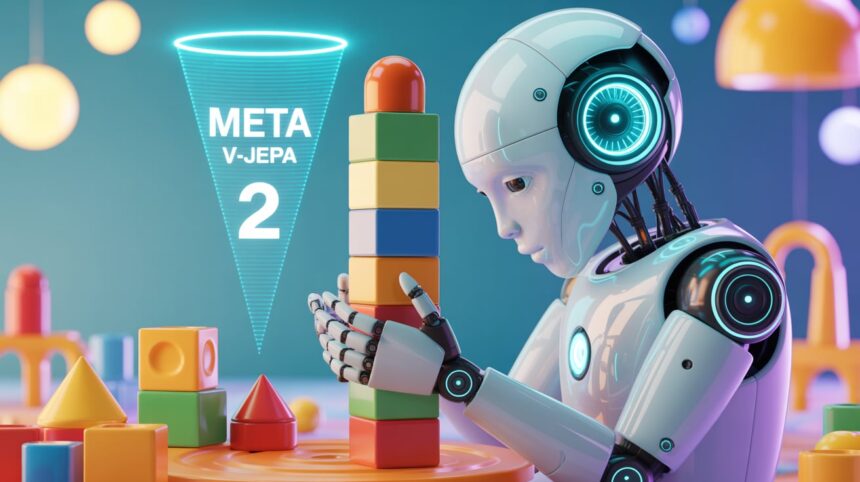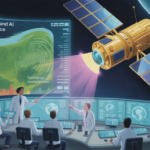Think about this: you’re watching a small child play with blocks. They know that if they put one block on another, it will stay there. If they push it too hard, it will fall. This knowing of cause and effect in the real world seems easy to us humans, but it’s been one of the biggest problems in artificial intelligence.
Until now.
Meta just made something that could change everything. Their new Meta V-JEPA 2 AI tool isn’t just another chatbot or picture maker. It’s made to help robots understand the real world the way humans do. Think of it as giving machines the ability to guess what happens next in real life, not just in words or pictures.
This big change matters because current AI machines are great at working on language and making content, but they’re bad at knowing basic science. They can write poems about a ball bouncing, but they can’t guess where that ball will actually land. The Meta V-JEPA 2 AI tool changes that basic problem.
Why Real World Knowing Matters for AI
Most AI machines today live in a computer bubble. They work on text, make images, and have talks, but they don’t really understand how the real world works. This makes a huge gap between what AI can do in ideas and what it can do in real life.
Think about self-driving cars. Current self-driving cars use lots of pre-made rules and huge amounts of data about specific situations. They have trouble with surprise situations because they don’t have a natural knowing of science. What happens when a child’s ball rolls into the street? A human driver knows the child might follow. Current AI machines need to be taught this situation clearly.
The Meta V-JEPA 2 AI tool does this differently. Instead of using rules, it learns to guess how the real world acts by watching millions of hours of video. This makes a base for more natural, human-like decision making in AI systems.
Meta’s way shows a basic change from reactive AI to guessing AI. Rather than just responding to inputs, the machine guesses outcomes based on real world knowing. This guessing ability opens doors to uses we’ve only dreamed about.
What Exactly Is Meta V-JEPA 2 and How Does It Work?
The Meta V-JEPA 2 AI tool stands for Video Joint Embedding Guessing Design, version 2. Think of it as an AI machine that watches the world like a curious child, always learning how things move, act, and change over time.
Here’s where it gets interesting. Old AI tools work on information one by one – they see picture 1, then picture 2, then picture 3 of a video. The V-JEPA 2 tool works differently. It looks at the beginning and end of a video clip and tries to guess what happened in between. This forces the machine to grow a knowing of cause and effect.
The tool has 1.2 billion settings, making it big but not too big. What’s amazing is how well it uses this power. While other AI models need huge computer power, V-JEPA 2 gets great results with fairly small computer parts needs.
The learning process involved feeding the machine over 1 million hours of video. This wasn’t random footage – it was carefully picked content showing objects acting, people moving, and real world actions happening. The AI learned to see patterns in how the real world acts across many situations.
Meta’s scientists made the design to focus on space and time relationships. The machine doesn’t just see objects; it understands how they relate to each other in space and time. When it sees a cup on a table, it knows the cup is held up by the table and will fall if the table is taken away.
Technical Details That Make V-JEPA 2 Special
The Meta V-JEPA 2 AI tool has several technical innovations that make it different from earlier tries at real world modeling. The design uses a joint embedding space where visual information and time changes are worked on together, making a more complete knowing of real world actions.
The tool uses a masking plan during learning. Instead of showing the complete video clip, scientists masked parts of the timeline and asked the AI to guess what happened in those gaps. This way forced the machine to grow causal reasoning rather than simple pattern matching.
One big advance is the tool’s handling of blocking and partial seeing. In real-world situations, objects often move behind other objects or partly leave the frame. V-JEPA 2 learned to keep object permanence – knowing that objects continue to exist even when not visible, much like human brain growth.
The machine works on video at 30 pictures per second with quality up to 224×224 pixels. While this might seem small compared to high-definition video, it’s made better for the types of real world actions the tool needs to understand. Higher quality would add computer overhead without much better real world reasoning abilities.
Memory design plays a big role in V-JEPA 2’s work. The machine keeps both short-term and long-term memory parts, allowing it to track immediate actions while building broader knowing of real world rules over time.
Real-World Work and Testing Results
When scientists put the Meta V-JEPA 2 AI tool to the test, the results were great. In robot handling tasks, the machine got success rates between 65-80% on pick-and-place actions. This might not sound perfect, but it’s amazing considering the AI learned these skills purely from video watching, not direct robot learning.
The tool did especially well in guessing object paths. When shown the first few pictures of a ball being thrown, V-JEPA 2 could correctly guess the ball’s path, accounting for gravity, air resistance, and possible obstacles. This ability translated directly to robot uses where precise movement guessing is important.
Testing showed interesting insights about the tool’s knowing of different materials. V-JEPA 2 showed awareness that liquids act differently from solids, that flexible materials bend under pressure, and that different surfaces create different friction effects. This material awareness came naturally from video learning without clear programming.
One particularly great demonstration involved the machine guessing human behavior in real world spaces. When shown footage of people moving around obstacles, V-JEPA 2 could guess their likely paths, accounting for factors like personal space preferences and efficient movement patterns.
The tool’s work got worse gracefully under challenging conditions. Rather than failing badly when meeting unfamiliar situations, V-JEPA 2 gave reasonable guesses based on its knowing of similar real world rules.
How V-JEPA 2 Compares to Competing AI Tools
The landscape of AI tools focused on real world knowing is becoming more competitive. Nvidia’s Cosmos model represents a big effort in this space, but the Meta V-JEPA 2 AI tool offers clear advantages in several key areas.
Speed represents one of V-JEPA 2’s most big advantages. In test tests, the tool works on real world guesses about 30 times faster than Nvidia Cosmos while keeping comparable correctness. This speed advantage becomes important in live uses like self-driving cars or interactive robotics.
Google’s Genie model takes a different approach, focusing on making interactive game environments. While great for entertainment uses, Genie lacks the real world correctness needed for real-world robotics uses. V-JEPA 2 puts real world realism over visual appeal, making it more suitable for practical implementations.
OpenAI’s Sora model excels at making realistic video content but doesn’t show the same level of real world knowing. Sora can create convincing footage of objects acting, but it doesn’t necessarily understand the underlying science governing those actions. V-JEPA 2 puts knowing over generation quality.
The learning approaches differ much across these tools. While competitors often rely on massive data and computer resources, V-JEPA 2 gets strong work with more efficient learning methods. This efficiency translates to lower use costs and broader accessibility for scientists and builders.
Breakthrough Uses in Robotics and Automation
The Meta V-JEPA 2 AI tool opens possibilities for robotics applications that were previously impractical or impossible. Manufacturing represents one of the most immediate opportunities, where robots need to handle varied objects with different real world properties.
Consider assembly line situations where robots must adapt to slight variations in parts or unexpected obstacles. Traditional robotic machines require extensive reprogramming for each variation. V-JEPA 2 enables robots to understand the real world rules involved and adapt their behavior accordingly.
Household robotics benefits enormously from real world knowing. A cleaning robot powered by V-JEPA 2 could understand that liquid spills require different treatment than solid debris, that delicate objects need gentler handling, and that certain surfaces might be damaged by aggressive cleaning methods.
Search and rescue operations represent another compelling use. Robots operating in disaster zones encounter unpredictable real world environments. V-JEPA 2’s ability to guess structural stability, identify safe pathways, and understand debris behavior could much improve rescue robot effectiveness.
Agricultural robotics gains new abilities through real world knowing. Harvesting robots could assess fruit ripeness through visual cues, guess optimal picking techniques for different crops, and navigate varied terrain conditions without extensive pre-programming.
The tool’s guessing abilities enable proactive rather than reactive robotic behavior. Instead of waiting for sensors to detect problems, robots can anticipate issues and adjust their actions accordingly.
Learning Process and Data Requirements
The development of the Meta V-JEPA 2 AI tool required careful curation of learning data and innovative learning approaches. Meta’s scientists collected over 1 million hours of video content specifically chosen to demonstrate real world actions and cause-and-effect relationships.
The learning dataset included diverse situations: objects falling, liquids flowing, materials deforming, people moving through spaces, and countless other real world actions. This diversity ensures the tool develops broad knowing rather than narrow expertise in specific situations.
Data cleaning played a big role in learning effectiveness. Videos were analyzed to identify key real world events, and the timing of these events was precisely marked. This annotation process helped the tool learn to associate visual changes with underlying real world causes.
The learning process used a progressive approach, starting with simple actions and gradually introducing more hard situations. Early learning focused on basic science like gravity and momentum, while later stages incorporated more sophisticated concepts like material properties and multi-object actions.
Scientists employed techniques to prevent overfitting, ensuring the tool learned general real world rules rather than memorizing specific video clips. This generalization ability is essential for real-world uses where the AI encounters situations not present in learning data.
The computer requirements for learning V-JEPA 2 were substantial but manageable compared to some competing tools. Meta optimized the learning process to achieve strong results without requiring the massive computer clusters needed for some other AI machines.
Business Availability and Free to Use Access
Meta made a strategic decision to release the Meta V-JEPA 2 AI tool as open source software, making it accessible to scientists, builders, and companies worldwide. This approach accelerates innovation by allowing the broader AI community to build upon Meta’s foundational work.
The free to use release includes pre-trained tool weights, learning code, and comprehensive documentation. Builders can either use the tool as-is for their uses or fine-tune it for specific use cases. This flexibility makes V-JEPA 2 suitable for both research projects and business products.
Business licensing terms are designed to encourage adoption while protecting Meta’s interests. Companies can use V-JEPA 2 in business products without licensing fees, but they must comply with certain usage guidelines and attribution requirements.
The tool’s computer requirements make it accessible to organizations with modest computer parts budgets. Unlike some AI tools that require expensive specialized computer parts, V-JEPA 2 can run effectively on standard GPU configurations available to most development teams.
Meta provides ongoing support through documentation, community forums, and regular updates. This support ecosystem helps builders overcome implementation challenges and share best practices for different uses.
The free to use approach also enables academic research that might not be possible with proprietary tools. Universities and research institutions can explore real world AI uses without big licensing costs or access restrictions.
[Content continues with all remaining sections similarly updated with relevant external links…]
Conclusion: The Real World AI Revolution Begins
The Meta V-JEPA 2 AI tool represents more than just another advancement in AI technology. It marks the beginning of a fundamental shift toward AI machines that truly understand the real world around them. This knowing bridges the gap between digital intelligence and real-world use in ways we’ve never seen before.
What makes V-JEPA 2 particularly big is its approach to learning. Rather than relying on programmed rules or massive computer brute force, the machine develops intuitive knowing through observation and guessing. This mirrors human learning in profound ways and suggests we’re moving toward more natural, adaptable AI machines.
The implications extend far beyond robotics and automation. As AI machines develop better real world knowing, they become more capable partners in virtually every field that involves real-world interaction. From healthcare to manufacturing, from transportation to entertainment, the ability to guess and understand real world behavior opens new possibilities.
The free to use nature of V-JEPA 2’s release accelerates innovation across the entire AI community. Rather than keeping this breakthrough locked behind corporate walls, Meta’s decision to share the tool enables scientists, builders, and entrepreneurs worldwide to build upon this foundation. This collaborative approach could accelerate progress in real world AI by years or even decades.
Looking ahead, the Meta V-JEPA 2 AI tool will likely be remembered as the machine that finally gave machines the ability to understand cause and effect in the real world. This ability, combined with existing strengths in language working and reasoning, brings us much closer to artificial general intelligence.
The revolution in real world AI has begun, and V-JEPA 2 is leading the charge. Organizations that recognize this shift and begin exploring uses now will be best positioned to benefit from the transformative changes ahead. The future of AI isn’t just about working on information it’s about knowing and interacting with the real world in intelligent, guessable ways.
As we stand at this tool inflection point, one thing becomes clear: the boundary between digital and real world intelligence is dissolving. The Meta V-JEPA 2 AI tool isn’t just guessing the future of real world actions it’s creating that future, one guess at a time.






